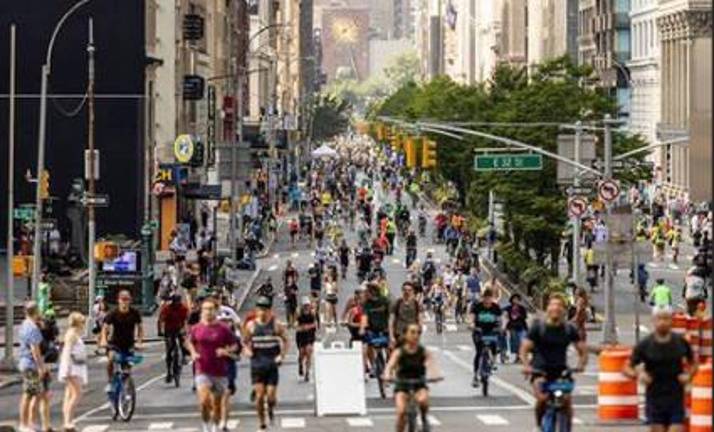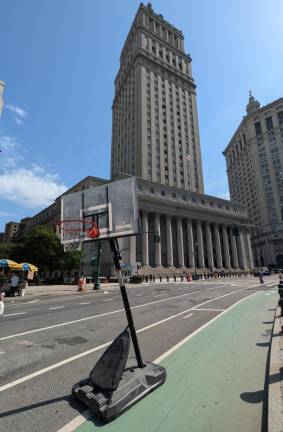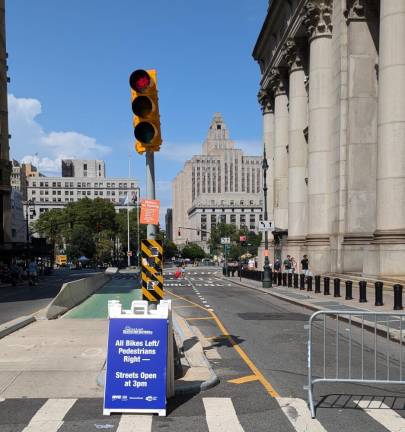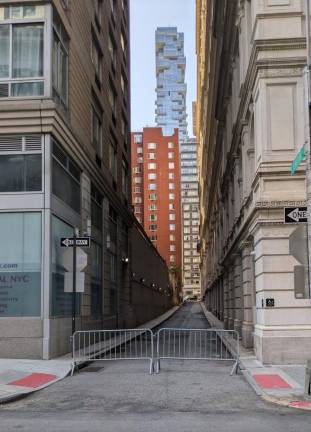Summer Streets 2024 Takes Manhattan
For three Saturdays in August, the Olympics of inspired pedestrianism proffers new worlds of possibility across long stretches of pavement that would otherwise be perilous on foot. Pedal bicycles and baby strollers are especially welcome too.
Ring-a-ding-ding!! Ring-a-ding-ding!!
That’s not the title—twice repeated— of the classic 1961 Frank Sinatra album but rather it’s the sound of an alarm going off in early morning so that one can enjoy this year’s Department of Transportation Summer Streets events to the fullest.
In Manhattan, where this annual event is held on three consecutive Saturdays in August, the official hours are 7 a.m.—which is welcome—to 3 p.m.—which seems a little bit early, in the erstwhile “city that never sleeps.”
Granted, the logistics of Summer Streets set up and take down, including the immense number of cops needed to guard the thousands of crosstown road barriers the event requires, is daunting.
The rewards for all this work are worth it, however—so much so, that one wishes more people could experience this vivid reimagining of Manhattan streetscape at least through sunset hours. Despite its premature mid-afternoon closure, the 2024 edition of Summer Streets is two hours longer than last year’s.
But, as the old saying goes “always leaving them wanting more,” and this is something DOT Commissioner Ydannis Rodriguez surely accomplished on August 3 in Manhattan.
The feat will be repeated—and could be done in reverse (Ding-ding-a-ring!!), from uptown to downtown—on August 10 and 17.
The route is a doozy, and mostly beautiful.
It begins, on its southern end, on Centre Street, just steps pas–t Brooklyn Bridge and the Municipal Building, and looking north toward the federal Thurgood Marshall Courthouse (formerly Foley Square); the Louis Lefkowitz State Office Building, where if it wasn’t Saturday one could get married; and the no longer swampy but still sometimes fetid Collect Pond Park, previously home to Manhattan’s most notorious jail, “The Tombs”–among other imposing monuments to our collective civic life.
Heading north up Lafayette Street, one can’t help but revel in often overlooked signs like those for White Street and Walker Street before crossing the unmissable Canal Street and passing by Hester Street—pausing to pay tribute to writer and director Joan Micklin Silver’s superb 1975 superb movie of the same name co-starring Carol Kane.
Drenched in sweat, one arrives in Astor Place to find it transformed into a veritable oasis, or as the DOT calls it, a “rest stop,” the first since Foley Square, with plenty more to follow.
The Astor Place rest stop is dedicated to variety of free fitness programs, including yoga, strength and cardio—a far, happy cry from the days when Astor Place was a veritable den of thieves’ flea market, with addicts peddling motley assortments of clearly stolen goods, sometimes including underground rock records pilfered from local music critics, in the plaza around The Cube.
Other rest stops, each featuring a different assortment of amenities and programs including music, food, art and games, are at Park Avenue and East 27th, East 51st, and East 109th Streets; and 7th Avenue (Adam Clayton Powell Blvd) at 110th and 125th Streets, the last being Summer Street’s terminus—or, in Harlem, its beginning.
Unlike some other well-intentioned DOT initiatives, such as the many “protected bike lanes” (sic) that have devolved into dangerous, high speed and often illegal e-bike, scooter and moped highways, Manhattan’s Summer Streets really are a pleasure to traverse by foot, pedal bicycle, rollerblades, children’s stroller, skateboard, maybe even a hippity hop.
Also, while Summer Streets primary goal is, as its name suggests, a reimagining of the uses of street space, the program also highlights what a disgrace many Manhattan sidewalks have become.
Imagine there’s no scaffolding, no crazy people underneath them threatening passersby, no plumes of a rancid weed smoke to rush through—it’s easy if you visit Summer Streets.
For more details on this year’s Summer Streets programs and the power of public optimism, visit the DOT website.



